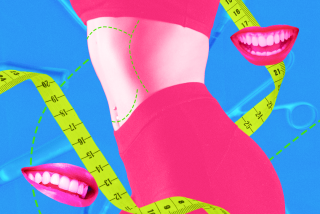A step ahead of diabetes
- Share via
Looking back on it, Mabe Sparks Vetra’s only symptom was napping. A couple of years ago, the 59-year-old attorney found herself drifting off to sleep midday -- something she hadn’t done since kindergarten. She chalked up the weariness to stress, age and the extra weight she’d been unable to take off.
Had it not been for her annual physical exam, Vetra might not have known for years that she had Type II diabetes. Of the estimated 17 million Americans with diabetes, about 16 million have Type II, the less severe form in which the body fails to make enough insulin or doesn’t properly use it. The condition results in elevated blood-sugar levels that can eventually lead to blindness, kidney failure, amputations, heart disease and stroke.
In fact, diabetes is the fifth-deadliest disease in the United States, killing more people each year than AIDS and breast cancer combined, according to the American Diabetes Assn. Linked to excess weight, the ranks of diabetics are expected to grow along with the nation’s climbing obesity rates.
“Type II diabetes is insidious,” said Dr. Francine Kaufman, head of endocrinology at Childrens Hospital of Los Angeles and president of the American Diabetes Assn. “People sometimes go on for years, even decades, undiagnosed. But all along, that high sugar is damaging their tissues.”
Although Vetra exhibited just one diabetic symptom -- others include frequent urination, thirst and wounds that don’t heal -- she did fit the profile of someone at risk for the disease. She had a family history (two grandparents had diabetes), she was older than 45, and she was overweight.
“I’m a woman that could out-eat anybody. I mean I could eat a whole pizza,” said Vetra, who had ballooned from about 120 pounds in her 30s to more than 250 pounds. “Every single year, I was putting on 10 pounds that wasn’t coming off.”
The disease can strike anyone, but certain groups are more vulnerable than others. Nearly half of all diabetes cases occur in people older than 55. African Americans, Latinos, American Indians and Alaska natives are all nearly twice as likely to contract the disease as whites. Women who have given birth to a baby weighing more than 9 pounds or who have been diagnosed with gestational diabetes are also at a higher risk.
Like many people who receive the news of diabetes, Vetra initially thought the worst.
“It seemed like a death sentence to my quality of life,” she said of a lab test in December 2001 that showed her blood-sugar levels were almost twice the normal levels. “I’m coming to the autumn of my life and I have my share of unfinished business, and I sure didn’t want this to impact me.”
But with early detection, Type II diabetes can be stalled, sometimes reversed, by revamping the diet and ramping up an exercise regimen. Because Vetra caught it early enough, she and her doctor decided her disease could be controlled without medication.
Even when medication is needed to regulate insulin, healthful diet and exercise habits are still essential in controlling the disease, doctors say.
“This is a disease you shouldn’t bury your head in the sand about,” said Kaufman. “If you take charge and get proactive, there’s a very good chance you can become well again.” After her diagnosis, Vetra embarked on a massive self-education program, reading dozens of books and articles about diabetes. Based upon that and her doctor’s advice, she mapped out radical lifestyle changes. First, she had to lose weight, so she immediately cut out what she called her trigger foods -- that is, foods that promoted binges. For her, this meant no peanut butter or chocolate.
“I absolutely took those two foods out my sight,” said Vetra, who also severely cut back her intake of breads and potatoes. “For a while, the only carbs I was eating was oatmeal.”
Avoiding certain foods was important, but so was controlling her portions, said Vetra. She began to eat six to eight small meals a day, avoiding processed foods and including as many vegetables as possible.
“The idea was not to get hungry, so I didn’t overeat,” she said. “But I was also looking to develop healthy eating patterns and keeping my readings low.”
In the first six months of her program, Vetra took a blood sugar reading about eight times a day. (Today, she is down to about four.) The test, performed with a drop of blood usually obtained by pricking a finger, helps patients monitor their blood-sugar levels.
While no stranger to exercise, Vetra never had to be as consistent as she is now. After building up to it, Vetra now walks for an hour every day, works out with weights four times a week and swims at least three times a week as well. The results have been dramatic: She’s already lost 70 pounds and plans to lose 65 more in the next year.
While she’s always at risk of the disease, Vetra feels confident in her ability to manage the condition. In fact, she’s back to eating about 90% of the foods she used to, but of course in smaller amounts and not crammed into just one or two meals.
“I didn’t do this by myself,” Vetra tells friends who wonder at her improved health. “I have diabetes at my heels.”






